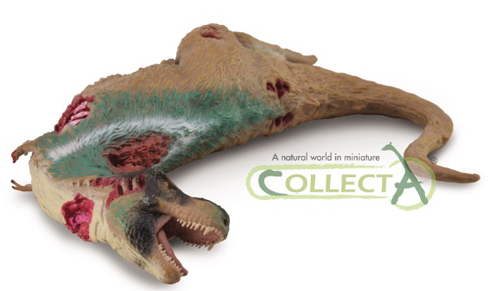Dinosaur Death Throes – Not what they Seem
One of the questions we were asked recently was why do all meat-eating dinosaurs seem to fossilise in the same way? A young dinosaur fan had pointed out that a picture in his dinosaur book showed two Coelophysis skeletons one of which had its neck and head curved backwards over the spine with the tail curling back on itself. In the same book, there was a picture of a Compsognathus fossil with the head and neck also curved over the back. How could these two dinosaurs have died in the same way?
Dinosaur Death Throes
We are familiar with these exhibits, the Coelophysis probably come from the famous Ghost Ranch deposits of New Mexico, where over 100 individual skeletons of this early Triassic theropod have been discovered. The Compsognathus example probably relates to the nearly complete Solnhofen specimen from southern Germany. This fossil was discovered in the lithographic limestone deposits in the same area as the first Archaeopteryx fossils. Compsognathus was a resident of the Jurassic, Coelophysis the Triassic, how could these two animals separated by millions of years have died in virtually the same posture? Indeed, when some of the Archaeopteryx fossils are studied, then they too show the head typically arched backwards over the spine. The tail does not curve round to any real extent, perhaps the tails of these early birds were too ossified to permit such movement, or maybe it is to do with the conditions of fossilisation at the southern German sites.
This phenomenon is not restricted to just some dinosaurs, a large number of articulated theropod (meat-eaters) fossils show this trait. Such postures are also seen in pterosaur fossils and birds. As we have driven along on our travels in the USA and elsewhere we have observed birds that have hit car windscreens and been killed. As the carcase dries out under the hot sun, the neck often adopts a curving posture.
An Exhibit of an Articulated Albertosaurus skeleton (Royal Tyrrell Museum)

Picture credit: Everything Dinosaur
The picture above shows a typical example of an articulated theropod fossil with the head and tail curving towards each other.
Most scientists believe that this common posture is caused by either one or a combination of two factors of post-mortem processes (after death). The first of these processes involves muscle contractions causing the neck and tail to bend over. Secondly, the posture could be caused by the the drying out of tendons and ligaments within the body as it remains exposed to the sun. Whether it is due to rigor mortis or the desiccation of the body, both possibilities indicate that these bodies must have remained intact on the ground for sometime before finally being buried.
Examples from the Natural World
These are valid explanations, borne out from our own observations of roadkill in hot climates, however, having visited Africa on numerous occasions we also note how rare it is for dead animals to lay undisturbed without attracting the attention of scavengers. One of our colleagues remembers working in the Masai Mara of Kenya when they had the misfortune to come across the body of a mature hippopotamus that had died only a few metres away from a small oasis which was being studied so that local elephant movements could be plotted.
Over the next few days, the pungent aroma of the rotting beast attracted a number of scavengers including hyenas, lions, marabou storks as well as vultures and the resident Nile crocodile. It was not long before the remains of the hippo and been well and truly taken to pieces. There were plenty of scavengers around in the Mesozoic, why were many of the bodies of the theropods not disturbed by other animals looking for an easy meal and the remains scattered about?
Another intriguing explanation for this death pose has recently been put forward. There are certain conditions, most closely associated with warm-blooded animals such as mammals and birds that can lead to this posture. A posture that is adopted when the animal is very much alive. One such condition is opisthotonos, this can lead to animals adopting a very rigid posture with the head and tail curving towards each other. This severe arching is caused by irritation of the membranes surrounding the brain or the spinal cord. In humans this condition is associated with meningitis in infants. Opisthotonos can also occur if there is brain damage (most notably the cerebellum), or any form of brain impairment leading to disruption to the nervous system.
There is some evidence of face biting amongst tyrannosaurs (another theropod), could many meat-eaters have suffered brain injuries when competing with other dinosaurs, this might have resulted in the condition that led to the “death pose” posture.
A Model of A T. rex Carcass
The picture (above) shows a model of a T. rex carcase, with the figure in the typical “death” position. This model is part of the CollectA Age of Dinosaurs Popular range: CollectA Age of Dinosaurs Popular Range.
As this disorder is most commonly associated with higher animals (mammals and birds), which are warm-blooded could this theory if true, also lend weight to the hypothesis that dinosaurs, at least the active, hunting, theropods were endothermic?







Hogwash, this pose is also present in fish fossils. The pristine nature of the fossils, as you commented, indicates the dead animal was not exposed for long. Consider if they were not exposed at all! Suppose they were suddenly and immediately covered while alive, with massive amounts of silt laden water. They would be stressed and gasping for air.
sorry to burst your bubble, but the spine of a fish doesn’t bend the same way a mammal’s does. ever watched a fish swim? it moves it’s spine horizontally. which is why dolphins and whales move their tails vertically. They descended from land based animals.